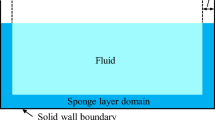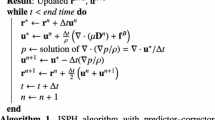Abstract
The air usually has a major influence on the water entry of a typical cavity body (cavity body is a hollow, cylindrical, semi-closed structure), which not only lowers the slamming load but also affects the dynamic characteristics of water entry. In this paper, a two-phase smoothed particle hydrodynamics (SPH) model for simulating the water entry of cavity body is presented. The SPH model combined with Riemann solver is improved to deal with the two-phase flows with the discontinuous quantities across the interface. One-sided Riemann problem is used to impose the fluid–structure interaction and a switch-function-based Riemann solver dissipation is formulated to improve the interfacial instability owing to the strong impact. The motion equations of rigid body are incorporated into two-phase SPH model to describe the motion of cavity body. The proposed model is validated by research on the test cases in the published literature. Finally, this work presents a study of water entry of cavity body by experiment and this two-phase SPH method. The dynamics phenomena in the coupling process between cavity body and two-phase flow are investigated. And the effects of air, mass, the sizes and incline angles of cavity body on the dynamic characteristics of cavity body and two-phase flows are shown.
Graphic abstract
An improved two-phase SPH model was used to simulate the water entry of cavity body. The cavity body impacts the water surface and the cavity body is closed by the flooding water. It comes into being open air cavity and water jets. The jet walls protrude and the air cavity is closed. With the increase of the water entry depth, the complex hydrodynamic phenomena can be seen again. The sinking depth shows the law of fluctuation up and down with time.




















Similar content being viewed by others
References
Yan, H., Liu, Y., Kominiarczuk, J., et al.: Cavity dynamics in water entry at low froude numbers. J. Fluid Mech. 641, 441–461 (2009)
Holland, K.T., Green, A.W., Abelev, A., et al.: Parameterization of the in-water motions of falling cylinders using high-speed video. Exp. Fluids. 37, 690–700 (2004)
Wang, L., Xu, F., Yang, Y.: SPH scheme for simulating the water entry of an elastomer. Ocean Eng. 178, 233–245 (2019)
Liu, H., Zhou, B., Han, X., et al.: Numerical simulation of water entry of an inclined cylinder. Ocean Eng. 215, 107908 (2020)
Kim, N., Park, H.: Water entry of rounded cylindrical bodies with different aspect ratios and surface conditions. J. Fluid Mech. 863, 757–788 (2019)
Lin, L.M., Zhong, X.F., Wu, Y.X.: Effect of perforation on flow past a conic cylinder at Re=100: wavy vortex and sign laws. Acta Mech. Sin. 34, 812–829 (2018)
Divsalar, K.: Improving the hydrodynamic performance of the SUBOFF bare hull model: a CFD approach. Acta Mech. Sin. 36, 44–56 (2020)
Nguyen, V.T., Vu, D.T., Park, W.G., et al.: Navier-Stokes solver for waterentry bodies with moving Chimera grid method in 6DOF motions. Comput. Fluids. 140, 19–38 (2016)
Iranmanesh, A., Passandideh-Fard, M.: A three-dimensional numerical approach on water entry of a horizontal circular cylinder using the volume of fluid technique. Ocean Eng. 130, 557–566 (2017)
Zhang, X., Lin, P.Q., Qu, Q.L., et al.: Effects of Froude number and geometry on water entry of a 2-D ellipse. J. Hydrodyn. 30, 738–749 (2018)
Kleefsman, K.M.T., Fekken, G., Veldman, A.E.P., et al.: A Volume-of-Fluid based simulation method for wave impact problems. J. Comput. Phys. 206, 363–393 (2005)
Lin, P.Z.: A fixed-grid model for simulation of a moving body in free surface flows. Comput. Fluid. 36, 549–561 (2007)
Wick, T.: Fluid-structure interactions using different mesh motion techniques. Comput. Struct. 89, 1456–1467 (2011)
Li, Y., Niu, X.D., Yuan, H.Z., et al.: A numerical study for WENO scheme-based on different lattice Boltzmann flux solver for compressible flows. Acta Mech. Sin. 34, 995–1014 (2018)
Monaghan, J.J.: Particle Methods for Hydrodynamics. Comput. Phys. Rep. 3, 71–124 (1985)
Liu, W.T., Sun, P.N., Ming, F.R., et al.: Application of particle splitting method for both hydrostatic and hydrodynamic cases in SPH. Acta Mech. Sin. 34, 601–613 (2017)
Dong, X.W., Liu, J.L., Liu, S., et al.: Quasi-static simulation of droplet morphologies using a smoothed particle hydrodynamics multiphase model. Acta Mech. Sin. 35, 32–44 (2019)
Liu, M.B., Zhang, Z.L.: Smoothed particle hydrodynamics (SPH) for modeling fluid-structure interactions. Sci. China Phys. Mech. Astronomy. 62, 5–42 (2019)
Bao, Y.Y., Li, L., Shen, L.m., et al.: Modified smoothed particle hydrodynamics approach for modelling dynamic contact angle hysteresis. Acta Mech. Sin. 35, 472–485 (2019).
Oger, G., Doring, M., Alessandrini, B., et al.: Two-dimensional SPH simulations of wedge water entries. J. Comput. Phys. 213, 803–822 (2006)
Vandamme, J., Zou, Q.P., Reeve, D.E.: Modeling floating object entry and exit using smoothed particle hydrodynamics. J. Waterw Port Coast. Ocean Eng. 137, 213–224 (2011)
Omidvar, P., Stansby, P.K., Rogers, B.D.: Wave body interaction in 2D using smoothed particle hydrodynamics(SPH) with variable particle mass. Int. J. Numer. Meth. Fl. 68, 686–705 (2012)
Cheng, H., Ming, F.R., Sun, P.N., et al.: Towards the modeling of the ditching of a ground-effect wing ship within the framework of the SPH method. Appl Ocean Res. 82, 370–384 (2019)
Lind, S.J., Stansby, P.K., Rogers, B.D., et al.: Numerical predictions of water-air wave slam using incompressible-compressible smoothed particle hydrodynamics. Appl. Ocean Res. 49, 57–71 (2015)
Gong, K., Shao, S.D., Liu, H., et al.: Two-phase SPH simulation of fluid-structure interactions. J. Fluids. Struct. 65, 155–179 (2016)
Marrone, S., Colagrossi, A., Park, J., et al.: Challenges on the numerical prediction of slamming loads on LNG tank insulation panels. Ocean Eng. 141, 512–530 (2017)
Zou, L., Zhu, G.X., Chen, Z., et al.: Numerical Investigation on the Water Entry of Convex Objects Using a Multiphase Smoothed Particle Hydrodynamics Model. Int. J. Comp. Meth. 15, 1850008 (2018)
Yan, R., Monaghan, J.J.: Valizadeh, A., et al.: The effect of air on solid body impact with water in two dimensions. J. Fluids Struct. 59, 146–164 (2015)
Monaghan, J.J.: Simulating free surface flows with SPH. J. Comput. Phys. 110, 399–406 (1994)
Yang. Q.Z., Xu, F., Wang. L., et al.: A multi-phase SPH model based on Riemann solvers for simulation of jet breakup. Eng. Anal. Bound. Elem. 111, 134–147 (2020)
Puri, K., Ramachandan, P.: Approximate Riemann solvers for the Godunov SPH (GSPH). J. Comput. Phys. 270, 432–458 (2014)
Zhang, C., Hu, X.Y.: A weakly compressible SPH method based on a low-dissipation Riemann solver. J. Comput. Phys. 335, 605–620 (2017)
Rezavand, M., Zhang, C., Hu, X.Y.: A weakly compressible SPH method for violent multi-phase flows with high density ratio. J. Comput. Phys. 109092 (2019)
Wendland, H.: Piecewise polynomial, positive definite and compactly supported radial functions of minimal degree. Adv. Comput. Math. 4, 389–396 (1995)
Cao, X.Y., Ming, F.R., Zhang, A.M., et al.: Multi-phase SPH modelling of air effect on the dynamic flooding of a damaged cabin. Comput. Fluids. 16, 37–19 (2018)
Sun, P.N., Le, T.D., Zhang, A.M.: Study of a complex fluid-structure dam-breaking benchmark problem using a multi-phase SPH method with APR. Eng. Anal. Bound. Elem. 104, 240–258 (2019)
Colagrossi, A., Landrini, M.: Numerical Simulation of Interfacial Flows by Smoothed Particle Hydrodynamics. J. Comput. Phys. 191, 448–475 (2003)
Zhang, A.M., Sun, P.N., Ming, F.R., et al,: Smoothed particle hydrodynamics and its applications in fluid–structure interactions. J. Hydrodyn. 29, 187–216(2017)
Adami, S., Hu, X.Y., Adams, N.A.: A generalized wall boundary condition for smoothed particle hydrodynamics. J. Comput. Phys. 231, 7057–7075 (2012)
Hiroshi, W.: Stability of velocity-Verlet- and Liouville-operator-derived algorithms to integrate non-Hamiltonian systems. J. Chem. Phys. 149, 154101 (2018)
Koh, C.G., Gao, M., Luo, C.: A new particle method for simulation of incompressible free surface flow problems. Internat. J. Numer. Methods Engrg. 89, 1582–1604 (2012)
Yettou, E.M., Desrochers, A., Champoux, Y.: Experimental study on the water impact of a symmetrical wedge. Fluid Dyn. Res. 38, 47–66 (2006)
Acknowledgements
This work was supported by the National Nature Science Foundations of China (Grant 11972309), the National Natural Science Foundation for Young Scientists of China (Grant 11702220), the Fundamental Research Funds for the Central Universities (Grant 310201901A012), and Overseas Expertise Introduction Project for Discipline Innovation (111 Project) (Grant BP0719007).
Author information
Authors and Affiliations
Corresponding author
Additional information
Executive Editor: Chao Sun
Rights and permissions
About this article
Cite this article
Yang, Q., Xu, F., Yang, Y. et al. Numerical study on the dynamic characteristics of water entry of cavity body using two-phase SPH method. Acta Mech. Sin. 37, 1072–1089 (2021). https://doi.org/10.1007/s10409-021-01060-8
Received:
Revised:
Accepted:
Published:
Issue Date:
DOI: https://doi.org/10.1007/s10409-021-01060-8




